Do you need more school advertising ideas? Today, we’re providing you with the inspiration you need. As a marketing agency with over 15 years of experience in educational marketing, we at HEM understand that school administrators and marketers face unique challenges when promoting their institutions. Traditional advertising methods may no longer yield the same results, and creative approaches are necessary to make a lasting impact.
Before we get the strategy, it’s important to define our goals. Though every institution has different objectives, generally, school advertising serves a unique purpose. What is the role of advertisement in education? Educational advertisements are crucial in creating awareness and attracting prospective students by effectively showcasing your educational institution’s unique features, values, and opportunities.
It helps your school to share your programs, campus life, and success stories, making you more accessible and appealing to a diverse audience. By utilizing targeted advertising strategies, you can reach students who align with your offerings, thus enhancing enrollment rates and fostering a more engaged student body. Additionally, advertising builds a school’s brand and reputation, helping to differentiate it from competitors in an increasingly crowded educational market. In this guide, we’ll walk you through five school advertising ideas, focusing on what works—and what to avoid—so that your marketing efforts are as effective as possible.
Idea 1: Virtual Campus Tours and Interactive Content
With the increasing reliance on online learning, offering prospective students a virtual tour of your campus has become a highly effective school advertising tactic. This strategy enables you to create an engaging experience that leaves a lasting impression. A static, pre-recorded tour might offer a different personal touch than students are looking for, so consider an interactive experience that allows them to explore your campus on their own terms.
Do make your virtual tour dynamic and customizable. It lets users choose their path, allowing them to click on different areas of the campus to explore further. This gives prospective students a sense of control and personalization, which is especially important if they cannot visit in person. You should also include interactive elements, like videos that feature current students or faculty members describing life on campus.
Example: Here, John Cabot University in Rome showcases its unique location and stunning campus in a virtual tour. Visitors can click on different parts of the campus, zoom in for a closer look, and zoom out for a view of the Eternal City.
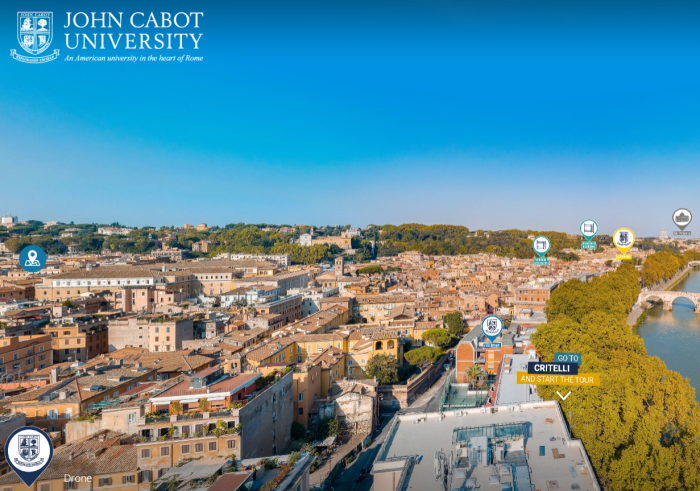
Source: John Cabot University
However, pay attention to the importance of high-quality production. A virtual tour riddled with poor-quality video, muffled sound, or outdated visuals will do more harm than good. Investing in professional video production ensures the user experience is smooth and engaging. Also, make the tour shorter. Prospective students, especially younger ones, often have shorter attention spans, so aim to keep the tour concise but informative.
If you could use more school advertising ideas, contact HEM here!
Idea 2: Personalized Email Campaigns
Email marketing has long been a reliable channel for reaching potential students, but its effectiveness hinges on personalization. A well-crafted email that speaks directly to students’ interests can do wonders for engagement rates. The key is to use your collected data wisely and create highly targeted email campaigns that resonate with specific student personas.
Personalize your emails based on the prospective student’s interests, location, and stage in the admissions funnel. Use their first names, reference the programs they have shown interest in, and offer tailored information about how your school can meet their needs. You could include information about extracurricular activities, scholarships, or campus events that align with their interests. Personalization can also extend to automated follow-up emails, keeping your school top-of-mind for students who may not have decided.
Example: Here, MIT targets a warm lead – someone already interested in a specific program. It uses the prospect’s name, states their program of interest, and provides an attractive but time-sensitive call to action at the end. When creating personalized email campaigns, use segmentation to ensure each email goes to the right individual. Email segmentation is the process of dividing an email list into smaller, targeted groups based on specific criteria such as demographics, behavior, or interests. This allows for more personalized and relevant email marketing, improving engagement and overall campaign effectiveness.
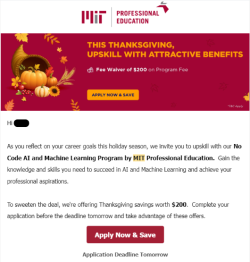
Source: MIT | Gmail
On the other hand, don’t rely on generic, one-size-fits-all emails. Mass emailing without personalization is an outdated approach that can turn off prospective students, making them feel like just another number. Additionally, avoid sending too many emails too frequently.
Bombarding your prospects with irrelevant or repetitive content could cause them to unsubscribe or mark your emails as spam. Finding the right balance between engagement and oversaturation is key.
Idea 3: Social Media Takeovers and Student-Generated Content
Social media remains one of the most powerful platforms for schools to engage with prospective students, especially when using platforms like Instagram, TikTok, and LinkedIn for graduate programs. One creative way to leverage social media is through student takeovers. Handing over your social media channels to current students for a day or even a week can offer an authentic look at what life is like at your school. Prospective students are more likely to trust the words and experiences of their peers than a polished marketing message.
Encourage students to share genuine, unfiltered content that represents their daily lives, whether that’s a behind-the-scenes look at classes, clubs, or dorm life. User-generated content can also effectively highlight diverse voices and experiences, allowing prospective students from all walks of life to see themselves reflected in your school’s culture. User-generated content showing real students living out their passions and making the most of their education can be a powerful marketing tool.
Example: This student takeover by Oxford University showcases a unique aspect of the school’s culture – formals! Student takeovers are an excellent school advertisement tactic for targeting students who view their learning experience as an opportunity to earn new certifications and make memories.
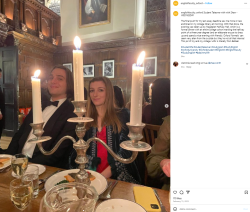
Source: Oxford University English Faculty | Instagram
However, don’t lose control over your brand’s messaging. While student-generated content should be authentic, it’s important to provide guidelines so that the content stays in line with your school’s values and branding. Avoid situations where inappropriate or irrelevant content is on your official platforms. Striking the right balance between authenticity and professionalism is crucial for this strategy’s success.
Idea 4: Search Engine Marketing (SEM) with a Focus on Long-Tail Keywords
Search engine marketing (SEM) is another essential strategy when advertising for schools. While general keywords like “best universities” or “top colleges” are incredibly competitive and expensive, long-tail keywords can help your school reach a more specific audience. For example, keywords like “best nursing programs in Ontario” or “liberal arts colleges with study abroad options” are more likely to attract students who are already well-informed in their decision-making process.
Do optimize your campaigns by focusing on long-tail keywords that match the unique aspects of your school’s programs. Conduct thorough keyword research to identify phrases that align with what makes your institution special. Additionally, ensure that your ads lead to well-designed landing pages relevant to the search query. If prospective students click on an ad about your nursing program, for example, they should be taken directly to a page with information on that program, not a generic landing page.
Example: In the metadata of Randolph-Macon Academy’s blog, the title and meta description have been optimized using the long-tail keyword ‘military boarding school’. Be sure to use specific and relevant keywords that fit your target audience.

Source: Randolph-Macon Academy
But don’t overspend on highly competitive keywords unlikely to yield significant results. Budgeting for SEM can be tricky, especially for schools with limited resources, so avoid the temptation to compete with bigger institutions on broad, expensive terms. Also, don’t neglect mobile optimization. Many students will be researching schools on their phones, so your SEM efforts should consider mobile-friendly landing pages and a seamless user experience across devices.
Idea 5: Influencer Partnerships and Micro-Influencers
The rise of influencer marketing has opened up new opportunities for schools to reach younger audiences, particularly through platforms like Instagram, YouTube, and TikTok. While partnering with mega-influencers can be costly and may not yield the desired results, working with micro-influencers—those with a smaller but highly engaged following—can be an excellent way to build trust with prospective students. These influencers, often niche content creators or even current students, can offer authentic endorsements of your school.
Do choose micro-influencers who align closely with your school’s values and the interests of your target audience. For instance, if you’re promoting a nursing program, you might partner with a healthcare-related influencer who can speak authentically to the value of your school’s education. Establish clear objectives for the partnership, whether increasing applications, building brand awareness, or driving traffic to your website.
Example: This is an excellent example of influencer content your school can use to reach prospects organically. Particularly when it comes to colleges and universities, students worldwide use the experiences of creators like Lydia, who are both relatable and aspirational, providing honest, helpful information about academics and student life. A small audience like Lydia’s is more likely to be trusting and have a very specific or niche interest in various subjects related to your school. Lydia’s YouTube channel posts authentic vlogs of her experience at Yale University, making her content perfect for any student considering enrollment there. You can launch an organic, effective, and cost-efficient school advertising campaign by partnering up with an influencer like her.
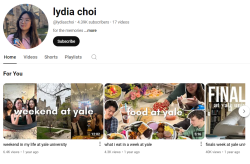
Source: Lydia Choi | Youtube
However, don’t choose influencers solely based on follower count. Engagement rates and the influencer’s connection to your target audience matter much more. Also, avoid overly scripted partnerships that come off as inauthentic. The power of influencer marketing lies in its relatability, so the content produced should feel organic and aligned with the influencer’s usual style.
Effective school advertising is about blending traditional marketing methods with creative, student-focused approaches such as the digital marketing tactics we’ve explored. You may have heard plenty of buzz around digital marketing, but you may still wonder: Do schools need digital marketers? Schools benefit from digital marketers to effectively reach and engage prospective students online, leveraging platforms like social media, search engines, and email to attract the right audience. Digital marketers use targeted campaigns and data-driven strategies to boost enrollment, enhance the institution’s visibility, and build a positive brand image in an increasingly competitive education landscape.
Idea 6: Video Advertising for Maximum Engagement
Video content is one of the most powerful tools in advertising. When it comes to promoting educational institutions, it offers an engaging way to communicate your school’s values, culture, and opportunities. Platforms like YouTube, Instagram, and TikTok provide an ideal space for reaching prospective students, allowing you to tell compelling stories that resonate emotionally. A well-crafted video can showcase your school’s strengths, provide testimonials from current students, and highlight campus life in a way that static images simply cannot.
Do make use of authentic storytelling in your video ads. Feature real students and staff sharing their experiences, whether about academic achievements, extracurricular activities, or campus culture. A relatable story goes a long way in building a genuine connection with your audience. It’s also important to tailor the content to the platform—short, catchy videos work great on TikTok, while longer, more in-depth content can thrive on YouTube. Keep your audience engaged by adding subtitles since many users watch videos on mute.
Don’t create overly promotional or staged content. Today’s students can easily spot a scripted advertisement that lacks authenticity. Avoid focusing only on flashy visuals without providing meaningful information; remember, the goal is to attract students genuinely interested in what your school offers. Monitoring your campaigns and understanding which video styles or narratives resonate with your audience is also essential.
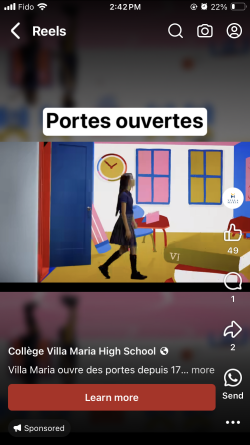
Source: Collège Villa Maria High School | Instagram
Example: Villa Maria High School uses an engaging video ad to share useful information regarding an open house. Use your advertising to guide prospects to the next desired outcome.
To help schools navigate the intricacies of video advertising and other digital campaigns, Higher Education Marketing offers specialized paid advertising services. Our team can help improve your school’s reach in crucial regions, target specific audiences effectively, and strategically remarket to existing leads. With a free consultation, we analyze your paid advertising strategy and identify areas for improvement, ensuring that you get the best return on your investment.
Whether you’re exploring virtual campus tours or into influencer partnerships, the key to success is connecting with your audience. Your school can stand out in a competitive market by focusing on high-quality, personalized, engaging content. Avoid pitfalls like impersonal messaging, poor production value, or misaligned partnerships. With these strategies, you’ll be well on your way to capturing the attention and interest of prospective students.
FAQs
What is the role of advertisement in education?
Educational advertisements are crucial in creating awareness and attracting prospective students by effectively showcasing your educational institution’s unique features, values, and opportunities.
Do schools need digital marketers?
Schools benefit from digital marketers to effectively reach and engage prospective students online, leveraging platforms like social media, search engines, and email to attract the right audience.







